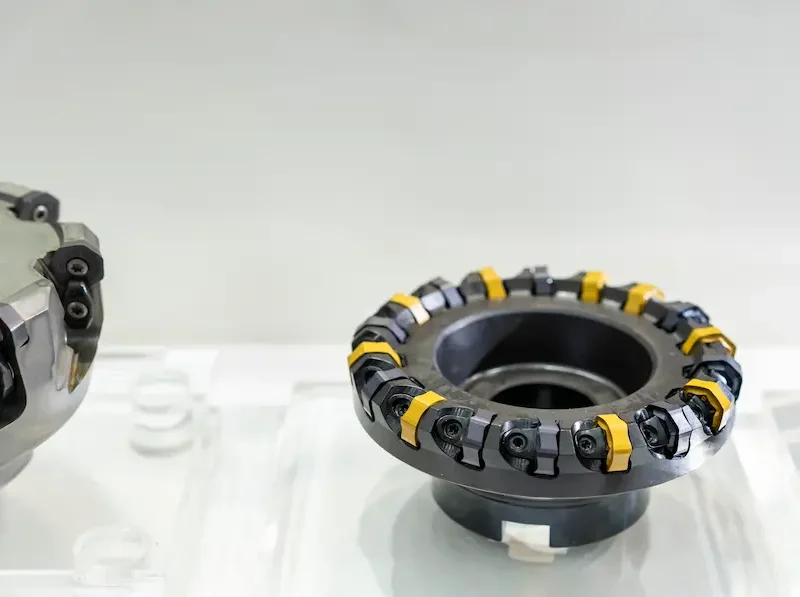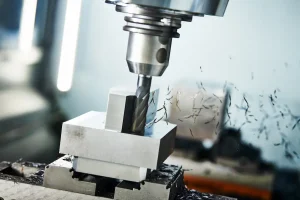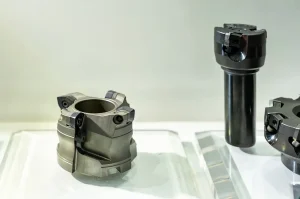
If you’re looking to add more variety to your milling operations, or if you need to remove large amounts of material quickly, shoulder milling is the way to go. This type of milling is versatile and can be used on a variety of materials. In this guide, we’ll cover everything you need to know about shoulder milling, including the different types of tools you can use, how to choose them adequately for your application, and general tips on how to take your shoulder milling operations to the next level.
Table of Contents
Shoulder Milling
Shoulder milling is a machining process in which the cutter is positioned at an angle relative to the workpiece, rather than perpendicular to it. The purpose of a shoulder mill is to create flat, angular surfaces on the workpiece.
A more technical definition would state that shoulder milling is any operation in which the machine tool axis is tilted from the normal line of travel of the material being cut, in the general direction of the surface on which the cutter lies. A 90-degree shoulder is the most common angle, but other angles can be used depending on the application.
What makes a shoulder mill cutter ideal for milling flat, angular surfaces? The need for constant access to the workpiece surface and cutting tools may be its biggest benefit. In contrast to chucking, the milling process cuts from top to bottom and side to side rather than in a straight line.
The different Types of Shoulder Mill Cutters.

There are several types of milling cutters, each designed for a specific purpose. The most common are:
Square shoulder milling cutters
A traditional square shoulder milling cutter is used in the milling process to create a clean, sharp edge on the workpiece. The square shoulder cutter is first mounted on the spindle and the workpiece is secured in place. It is then moved across the surface of the workpiece, removing material as it goes.
End milling cutter
An end milling cutter is a type of milling cutter used in metalworking. It is similar to a drill bit in that it has a cutting edge at the end, but it is also like a router bit in that it has flutes or teeth on the sides.
End milling cutters have slots on both sides which can be used to direct the travel of the cutter along with the material. These slots can also be used to guide the cut being created by the cutter as it moves across the material.
The indexable shoulder milling cutter
Indexable cutters offer a great solution for machining large or small shoulders. The indexable inserts have multiple cutting edges, making them perfect for tackling any size shoulder. The cutter is secured by its flange which maintains a tight clamping action between the cutter and inserts. This system allows for the full use of the depth of cut produced by the cutter.
Solid carbide cutters
Solid carbide milling cutters are used to produce precise, repeatable cuts in a variety of materials. The solid carbide body of the milling cutter reduces overall friction with the material being cut, which ensures the cutting edges stay sharp and produce clean cuts.
Face milling cutters
Face milling cutter tools typically have a larger cutter diameter than end milling tools and are used for machining flat surfaces, such as those found in shoulders. In some cases the profile of a part can be turned down to create a surface with less material, but which is still larger than a conventional end milling cutter.
How to select the right shoulder milling cutter for the job.
There are a few things you need to consider when selecting the right shoulder mill cutter for the right application.
The size of the workpiece.
The size of the workpiece will determine the size of the cutter. End milling cutters for example are the best option for working with small workpieces. They are specially designed for milling small workpieces and can be used on a wide variety of materials.
The material of the workpiece.
The material of the workpiece will determine the type of cutter you need. However, the best milling tool for a given material will also depend on a number of factors, including the specific application and the individual preferences of the user. However, some general tips on choosing the right milling tool for a given material include considering the hardness of the material, the type of finish desired, and the depth of the cut. Carbide-tipped shoulder mill cutters for example are good for milling most types of materials, including steel, cast iron, aluminum, and brass.
The speed of the spindle.
The speed of the spindle will determine the feed rate of the cutter. It is recommended to choose a cutter with a high-speed rating and a sharp cutting edge. Additionally, it is important to consider the material being cut and the depth of the cut when selecting a cutter.
The cutter head.
The cutter head will determine the ability of the cutter to cut in more than one direction. If you need to make beveled cuts or cuts at an angle, you will need a cutter head that will allow for those types of cuts. An ideal scutter would have a cutter head with a small diameter and a long cutting edge length. The cutter head should be able to rotate at high speeds and have a large number of cutting teeth.
Tips for successful shoulder milling operations.
Some recommendations for successful shoulder milling operation include:
- Use a sharp cutting tool for best results. A cutter that is too dull or of poor quality will produce a poor finish and may cause damage to the workpiece.
- Set the speed and feed rate properly for the material being machined.
- Use coolant if necessary to prevent chip build-up.
- Take shallow cuts to avoid vibration.
- Use a rigid setup to avoid chatter.
- Avoid using too much pressure on the cutter.
- Use a ramping or spiral milling technique to avoid abrupt changes in direction.

